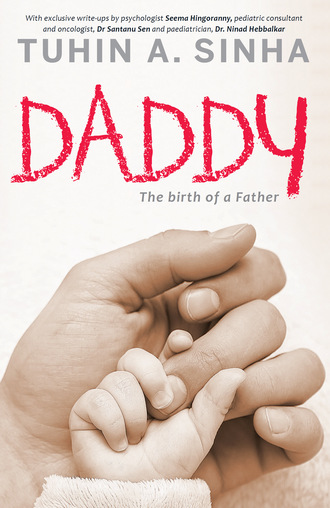
Полная версия
Daddy
Five weeks later came the all-important nuchal translucency scan. This is also the scan after which most people break the news to the world. A nuchal scan helps identify higher risks of chromosomal defects, including Down’s Syndrome in a foetus. ]This scan is carried out at 11–13.6 weeks of pregnancy and assesses the thickness of the soft tissues at the nape of neck. From the information I got off the Web, I learnt that the nuchal thickness ought to measure less than 2.2 mm. Hence, I was fixated on this figure throughout the scan.
As the doctor took us through the different body parts of the foetus, I stopped and asked, “Hold on, will you first please tell me the nuchal thickness?” The doctor looked back in surprise. He wondered how I was aware of such technicalities. “1.2 mm,” he answered quietly. “Oh, great! You can proceed with what you were saying,” I replied in relief. Ramyani stifled her laughter as the bemused doctor continued the scan.
The other crucial hurdle is the mid-semester scan. As the name suggests, this is done mid-way, around the 20th week of pregnancy. If your radiologist is not in a tearing rush to move on to the next patient, this one can go on for a good half hour. I assure you by the end of it you would count it among your most beautiful experiences ever. I was told that if the expectant mother consumes something sweet just before the ultrasound, the baby’s movements are more pronounced. We couldn’t wait to test this theory. The logic behind it is simple—sugar increases the glucose levels in the blood, leading to increased activity of the baby. In this scan, each body part is focused upon in turns. For the first time we got a clear look at the shape of the baby’s head, the limbs and heart.
The baby held both his hands together, as if greeting us with a Namaste. On our way out I told Ramyani, “I think I noticed something.” “What?” she asked unsuspectingly. “That it’s probably going to be a boy,” I said.
Stem cell banking
A few weeks before Tanish’s birth, Ramyani and I signed up for stem cell banking. There are several private or personal banks in the country that store stem cells extracted from the amniotic fluid of the child. This can later be accessed by the person whose stem cells have been banked or his/her immediate relatives in case of a medical emergency. The concept of stem cell banking has been active for many years in India but the parents I spoke to were all sceptical about the credibility of the companies. Since it is originally a western concept, I guess they were doubtful if the services in India could match international standards.
I was very keen that we go in for it while Ramyani was not. I looked at it as medical insurance for the baby. ‘Why cut corners when it comes to shielding your baby from potential health risks,’ I thought? Our doctor said we should opt for it if money was not an issue. The rates ranged between Rs 70,000-1,00,000 at that time. We chose an offer by Cordlife India. Asad opted for a brand called Life Cell. “They were prompt and almost professional. It was only after Aishwarya Rai Bachchan decided to be a spokesperson for it and their full page ad in The Times of India did the service get a tad bit slow. I guess they were overwhelmed with calls!” he says.
The exorbitant rates of stem cell banking could pose as a deterrent for those considering it. My friend in Bangalore, Zahid H Javali, decided against it because he felt it was too large an investment on something that may or may not be worth it. “The practice isn’t as standardised and widespread as it is in the western countries. The proper care and upkeep of stem cells is a concern. Not too many people are qualified and committed to the cause of medical hygiene,” reasons Zahid, who runs his own custom publishing firm. His concerns seem to be valid, but then again, there are parents who did not go in for stem cell banking for the same reasons, and regret it now. In such cases, Zahid says parents can make things right by opting for dental stem cell banking which can be done while the child still has milk teeth.
THINGS TO REMEMBER
Once you know your wife is expecting, finalizing the right gynaecologist and hospital should be your top priority.
Information never hurts! Get yourself enrolled to www.babycenter.in for weekly updates on the development of the baby and advancement of your wife’s pregnancy.
Have your wife take the blood tests and ultrasounds on time. Some of the early ones can be discomforting for the new mother, especially if it is a vaginal ultrasound. Give her the moral support and encouragement she needs to see her through this phase.
The right time to clean up and re-design your home or to shift to a new one is before the baby is born. Dust particles are best avoided once the baby is born.
Accompany your wife to the ultrasounds. They are the closest interface that you can have with your baby before he is born, so make the most of it.
Go in for stem cell banking, unless you can’t afford it. Treat it as a form of medical insurance. The good thing is that it might be useful for your blood relatives as well.
Конец ознакомительного фрагмента.
Текст предоставлен ООО «ЛитРес».
Прочитайте эту книгу целиком, купив полную легальную версию на ЛитРес.
Безопасно оплатить книгу можно банковской картой Visa, MasterCard, Maestro, со счета мобильного телефона, с платежного терминала, в салоне МТС или Связной, через PayPal, WebMoney, Яндекс.Деньги, QIWI Кошелек, бонусными картами или другим удобным Вам способом.



